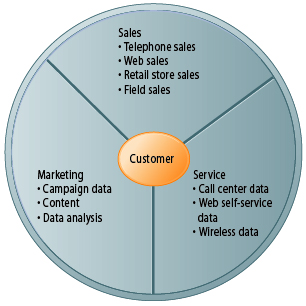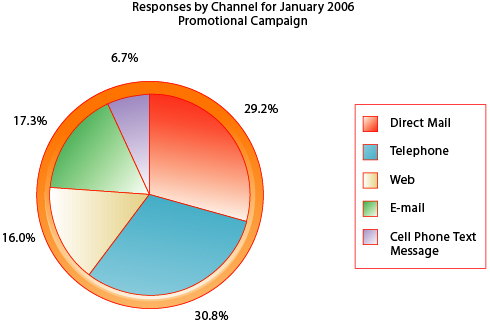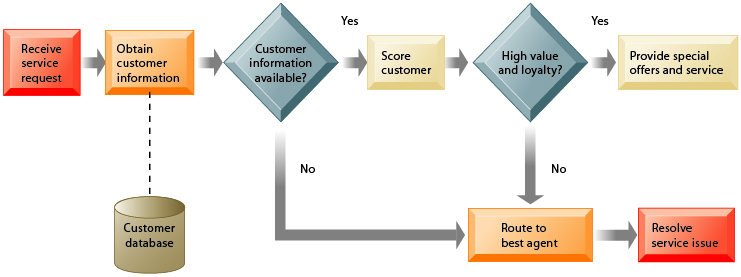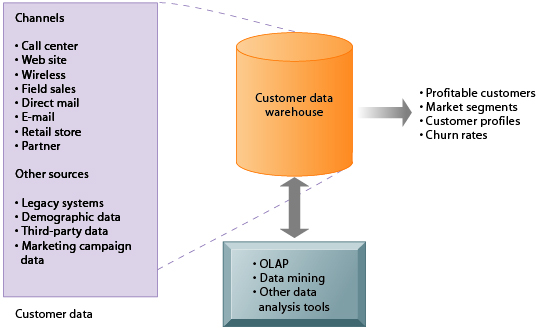Customer Relationship Management Systems
Customers can be seen as an enterprise's most valuable asset, and customer relationship management systems enable large firms to understand and work with their customers.
CRM systems capture and integrate customer data from all over the organization, consolidating the data, analyzing the data, and then distributing the results to various systems and customer touch points across the enterprise. A touch point (also known as a contact point) is a method of interaction with the customer, such as telephone, e-mail, customer service desk, conventional mail, Web site, or retail store.
Well-designed CRM systems provide a single enterprise view of the customer and provide customers with a single view of the company regardless of the touch point the customer uses.
Figure 9-7
|
FIGURE 9-7 CUSTOMER RELATIONSHIP MANAGEMENT (CRM)
CRM systems examine customers from a multifaceted perspective. These systems use a set of
integrated applications to address all aspects of the customer relationship, including customer
service, sales, and marketing. |
Good CRM systems provide data and analytical tools for determining the financial lifetime value of a customer and customer loyalty and for identifying profitable customers and their needs.
Commercial customer relationship management (CRM) software packages range from niche tools that perform limited functions, such as personalizing Web sites for specific customers, to large-scale enterprise applications. The more comprehensive CRM packages contain modules for:
- Partner relationship management (PRM): PRM software uses many of the same data, tools, and systems as customer relationship management to enhance collaboration between a company and its selling partners. It provides a company and its selling partners with the ability to trade information and distribute leads and data about customers, integrating lead generation, pricing, promotions, order configurations, and availability.
- Employee relationship management (ERM). ERM software deals with employee issues that are closely related to CRM, such as setting objectives, employee performance management, performance-based compensation, and employee training.
CRM systems typically provide software or tools for:
- Sales force automation (SFA): SFA modules help sales staff increase their productivity by focusing sales efforts on the most profitable customers. They provide sales prospect and contact information, product information, product configuration capabilities, and sales quote generation capabilities.
- Customer service: Customer service modules provide information and tools to make call centers, help desks, and customer support staff more efficient. They have capabilities for assigning and managing customer service requests and may include Web-based self-service capabilities.
- Marketing: Marketing modules support direct-marketing campaigns with capabilities for capturing prospect and customer data, qualifying leads, and scheduling and tracking campaign mailings. They include tools for analyzing marketing and customer data-identifying profitable and unprofitable customers, designing products and services to satisfy specific customer needs and interests, and identifying opportunities for cross-selling, up-selling, and bundling. Cross-selling is the marketing of complementary products to customers. Up-selling is the marketing of higher-value products or services to new or existing customers. Bundling is cross-selling in which a combination of products is sold as a bundle at a price lower than the total cost of the individual products.
Figure 9-8, Figure 9-9
|
FIGURE 9-8 HOW CRM SYSTEMS SUPPORT MARKETING
Customer relationship management software provides a single point for users to manage and evaluate
marketing campaigns across multiple channels, including e-mail, direct mail, telephone, the Web, and
wireless messages. |
|
FIGURE 9-9 CRM SOFTWARE CAPABILITIES
The major CRM software products support business processes in sales, service, and marketing,
integrating customer information from many different sources. Included are support for both the
operational and analytical aspects of CRM. |
CRM software can also be used to increase customer loyalty through customer service by identifying valued customers and providing them with special services or offers.
Figure 9-10
|
FIGURE 9-10 CUSTOMER LOYALTY MANAGEMENT PROCESS MAP
This process map shows how a best practice for promoting customer loyalty through customer service would be modeled by customer relationship management software. The CRM software helps firms identify high-value customers for preferential treatment. |
CRM applications may support either:
- Operational CRM: Customer facing applications such as tools for sales force automation, call center and customer service support, and marketing automation.
- Analytical CRM: Applications that analyze customer data generated by operational CRM applications to provide information for improving business performance management. Analytical CRM applications are based on data warehouses that consolidate the data from operational CRM systems and customer touch points for use with online analytical processing (OLAP), data mining, and other data analysis techniques. An important output of analytical CRM is the customer lifetime value (CLTV). CLTV is based on the relationship between the revenue produced by a specific customer, the expenses incurred in acquiring and servicing that customer, and the expected life of the relationship between the customer and the company.
Figure 9-11
|
FIGURE 9-11 ANALYTICAL CRM DATA WAREHOUSE
Analytical CRM uses a customer data warehouse and tools to analyze customer data collected from
the firmís customer touch points and from other sources. |
The business value of CRM systems includes
- Increased customer satisfaction
- Reduced direct-marketing costs
- More effective marketing
- Lower costs for customer acquisition and retention
- Increased sales revenues through identifying profitable customers
- Reduced churn rate: The churn rate measures the number of customers who stop using or purchasing products or services from a company and is an important indicator of the growth or decline of a firm's customer base.
|




